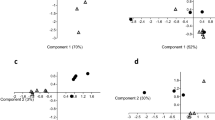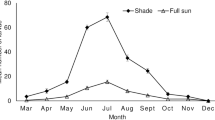Abstract
A diverse array of sublethal plant secondary compounds are commonly found in the foliage of temperate deciduous trees. These traits are thought to defend a plant in two principal ways, either directly by reducing insect oviposition, feeding, or biomass gain, or indirectly, through digestive inhibition. Such inhibition is hypothesized to slow the rate of herbivore development, thereby increasing their susceptibility to natural enemies (the slow-growth-high-mortality hypothesis). To clarify the defensive role of these compounds, field experiments were conducted to examine the relationships among oak leaf quality, herbivore family, and three herbivore performance measures: survivorship, development time, and pupal mass, for a bivoltine leaf-tying caterpillar, Psilocorsis quercicella (Lepidoptera: Oecophoridae). Two experiments, one for each generation of the insect, were conducted to examine the effects of intraspecific variation in leaf chemistry of its host, white oak trees (Quercus alba). In each experiment, full-sib neonate larvae were placed in experimental leaf ties on high- versus low-quality trees and allowed to feed for 2 weeks under field conditions. To determine the effect of the third trophic level, a portion of each family in each leaf-quality treatment was bagged to prevent attack from natural enemies. This treatment also allowed us to test a prediction of the slow-growth-high-mortality hypothesis, i.e., that development time, as measured for full sibs in the bagged treatment, should be positively correlated with mortality of their full sibs exposed to natural enemies. Low leaf quality significantly reduced survivorship of the caterpillars in the first generation but not the second. The third trophic level decreased survivorship in both generations. Larval development time was not affected by leaf quality in either generation, but varied significantly among insect families in both generations. In turn, larvae from slower-developing families did not suffer increased predation and parasitism, as predicted by the slow-growth-high mortality hypothesis. In contrast to development time, pupal mass showed a greater response to intraspecific variation in leaf quality, although the effect was only significant in generation 1. Concentrations of both total phenolics and hydrolyzable tannins in Q. alba foliage appear to be important negative predictors of pupal mass in P. quercicella. In marked contrast to development time, no main family effect was found for pupal mass in either experiment; however, significant family×environment interactions were found for the effects of the bagging treatment (generation 1) and the leaf-quality treatment (generation 2). Overall, the first trophic level had a greater influence on pupal mass (a fecundity correlate), while larval development time was determined more by the insect's family (genotype+maternal environment). The third trophic level was a consistently strong source of mortality in both experiments, but as a whole did not respond to familial differences in development time. Thus, from the perspective of P. quercicella, plant quality appears to serve as a defense more through its direct effect on herbivore survivorship and fecundity than through an indirect effect on predation via changes in development time.
Similar content being viewed by others
Author information
Authors and Affiliations
Additional information
Electronic Publication
Rights and permissions
About this article
Cite this article
Lill, J., Marquis, R. The effects of leaf quality on herbivore performance and attack from natural enemies. Oecologia 126, 418–428 (2001). https://doi.org/10.1007/s004420000557
Received:
Accepted:
Published:
Issue Date:
DOI: https://doi.org/10.1007/s004420000557




